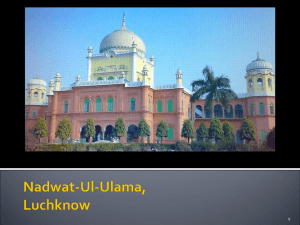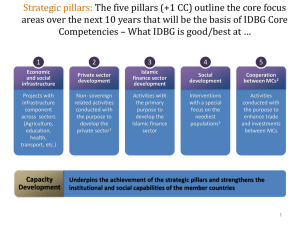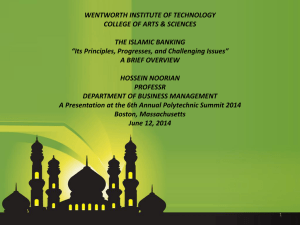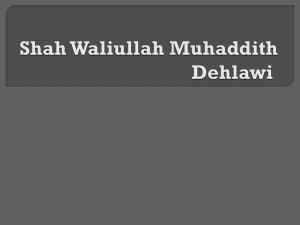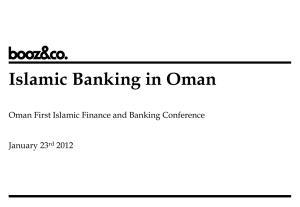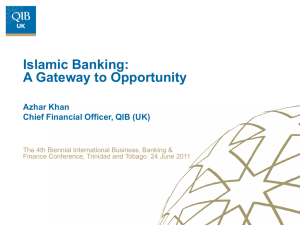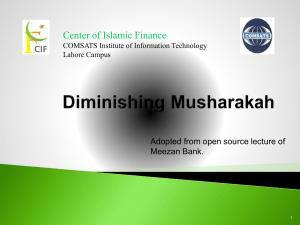minggu 1maklumat kursus CTU351
advertisement
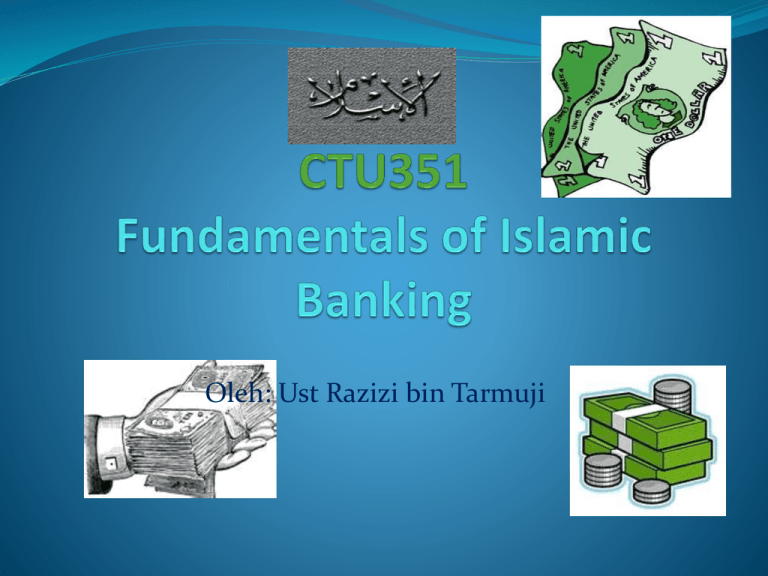
Oleh: Ust Razizi bin Tarmuji Course Outcomes At the end of this course, students should be able to: Explain the essentials of Shariah-compliant banking system. Differentiate Islamic Banking System (IBS) against the conventional system. Evaluate the modus operandi of Shariah-compliant investments/instruments and financing facilities under the Islamic Banking System. Course Description This is an introductory course to Islamic Banking for students to understand the fundamentals of Shariahcompliance banking system. Students will be introduced to the concepts and principles adopted/adapted by Islamic banks to comply with the Shariah requirements. The course will equip students with the basics to distinguish between Islamic and conventional banking system, expose students to the modus operandi of selected facilities/instruments offered by Islamic banks and assist them in evaluating the value proposition promoted by Islamic Banking System. Syllabus Content 1. Overview of Financial System 1.1 Financial Markets and Institutions 1.2 Roles of Banks as Financial Intermediaries 2. Framework of Islamic Financial System Islamic Banking, Takaful, Islamic Capital Market (ICM) and Islamic Interbank Money Market (IIMM) Historical Development of Islamic Banking Structure of Islamic Bank 3. Compliance to the Scheme of Shariah Laws 3.1 Primary and Secondary Sources of Shariah Laws 3.2 Aqidah, Akhlaq, Shariah ( Ibadat & Muamalat ) 3.3 Ethics in Islamic Financial System 4. Principles of Islamic Banking 4.1 Investment and Financing of Halal (permissible) Activities 4.2 Profit and Loss Sharing vs Lender-Borrower Relationship 4.3 Trade-based Financing vs Interest-based Investments/Loans 4.4 Prohibition of Riba, Gharar (unnecessary risk) and Maysir (gambling / speculation) 4.5 Payment of Zakat 5. Sources of Funds - Savings/Investments and the underlying Shariah Concepts Al-Wadiah/Al-Mudarabah Savings Accounts Al-Wadiah/Al-Mudarabah Current Accounts Al-Mudarabah General Investment Accounts (MGIA) Al-Mudarabah Special Investment Accounts (MSIA) 6. Application of Funds - Financing Facilities and the underlying Shariah Concepts 6.1 Home/Property Financing (Bai’ Bithaman Ajil / BBA) 6.2 Home/Property Financing (Musharakah)(Musharakah Mutanaqisah) 6.3 Motor Vehicle Financing (Al-Ijarah) (Al-Ijarah Thumma al-Bai’) 6.4 Personal Financing (Bai’ al-Inah) 6.5 Credit Cards (Al-Wadiah)( Bai’ al-Inah)(Qard al- Hasan) 6.6 Project Financing (Al-Mudarabah) (Al-Musharakah) 6.7 Acquisition of Assets (Al-Bai’ Bithaman Ajil) 6.8 Working Capital Financing (Al-Murabahah ) 6.9 Letter of Credit (Wakalah) (Musharakah) (Murabahah) 6.10 Islamic Accepted Bills (Bai` al-Dayn) 6.11 Islamic Export Credit Refinancing (IECR) 7. Treasury 7.1 Islamic Inter-Bank Money Market 7.2 Foreign Exchange Trading 8. Other Services Agency (Al-Wakalah) Guarantee (Al-Kafalah) Commission (Ju’alah) Fee (Al-Ujr) Remittance (Al-Hiwalah) Currency Exchange (Al-Sarf) Teaching Methodology Lecture Discussion Active Learning Assessment Continuous Assessment 50% Test - 15% Assignment – 15% Presentation – 20% Total- 50 Final Exam 50% References 1. 2. 3. 4. 5. 6. 7. 8. Rosly, Saiful Azhar, Dr (2005). Critical Issues on Islamic Banking and Financial Markets. Kuala Lumpur: Dinamas Publishing. Haron, Sudin, Dr & Shanmugam, Bala. (2001). Islamic Banking System: Concepts & Applications. Malaysia: Pelanduk Publications. Islamic Banking Practice from The Practitioner’s Perspective. (1994). Kuala Lumpur: Bank Islam Malaysia Berhad. Usmani, Muhammad Imran Ashraf, Dr (2002). Meezanbank’s Guide to Islamic Banking. Karachi: Darul Ishaat. Gafoor.A.L.M, Abdul. (2005). Interest, Usury, Riba and The Operational Costs of a Bank. Kuala Lumpur: A.S.Noordeen Shanmugam, B., Perumal.V., & Ridzwa.A.H. (Eds.)(2004) Islamic Banking: An International Perspective. Serdang: Universiti Putra Malaysia Press. Usmani, Muhammad Taqi, Justice Mufti (2002). An Introduction to Islamic Finance. Karachi: Maktaba Ma’arifatul Quran. Web page: http://razizi.uitm.edu.my Edisi Pelajar FORMAT PENULISAN KERTAS KERJA Tajuk : Berdasarkan kepada Silibus. Jumlah Mukasurat : 10 – 15/ 1000 – 2000 patah perkataan Font : Times New Roman -12 ; Arial – 11. Langkau Baris : 1.5 atau 2.0 Rujukan/Bibliografi : Tidak kurang dari 5 buah buku. Penulisan Rujukan: Citation - APA system (Pengarang, tahun, hal.). Contoh : Pentadbiran ialah ..... (Mohd Asri, 2010. hal. 2) atau Menurut Ahmad Ibrahim Abu Sin (2008, hal.2), Pentadbiran ialah... Penulisan Bibliografi : Nama Pengarang. Tahun. Nama Buku. Tempat Terbit: Penerbit. Contoh : Mohd Asri Abdullah. 2010. Islam dan Pengurusan. Kuala Lumpur : Dewan Bahasa dan Pustaka.
